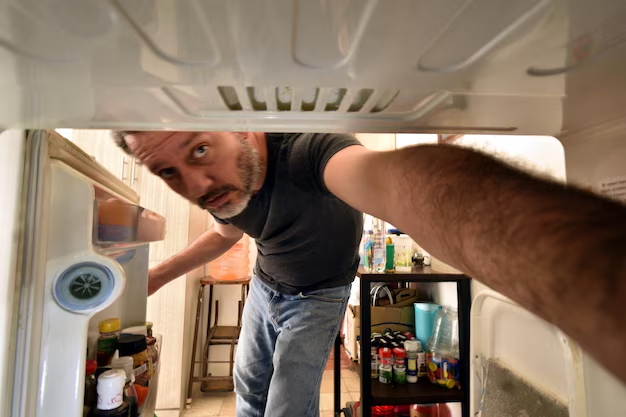Keep Your Garage Refrigerator Functioning: Tips to Prevent Freezing
Imagine you step into your garage on a cold winter morning, only to find that your fridge, typically a steward of cool but consistent temperatures, has turned into a mini Arctic tundra. If you store perishables in your garage refrigerator, it's crucial to keep this appliance from freezing your groceries solid. While garages are handy spaces for extra refrigeration, their unregulated environments can present some unique challenges. This guide dives into practical ways to manage your garage refrigerator, ensuring it operates smoothly through every season.
Understanding the Challenges of a Garage Fridge
A garage may seem like the perfect spot for an extra refrigerator. However, the very essence of its environment makes it susceptible to extreme temperature fluctuations. Garage fridges face challenges such as exposure to cold drafts in winter, lack of insulation, and proximity to garage doors that are frequently opened and closed. These factors can create conditions where the ambient temperature around the refrigerator drops significantly, causing the freezer compartment to overwork and sometimes leading to the fresh food compartment freezing up.
Why Does the Freezing Happen?
Several factors contribute to your garage refrigerator struggling with cold temperatures:
- Insulation Deficiency: Garages tend not to be as well-insulated as other parts of a house, allowing temperatures to plummet, particularly in winter.
- Temperature Settings: Standard refrigerator settings assume a stable environment, typically between 60ºF and 80ºF, which a garage doesn't consistently maintain.
- Thermoregulation: Most refrigerators are designed to regulate internal temperatures based on outside ambient temperature. Dramatic decreases can lead the unit to misjudge the necessary cooling levels, sometimes excessively lowering the temperature.
Steps to Prevent Your Garage Fridge from Freezing
Choose an Appliance Designed for Extreme Temperatures
✔️ Recommended Step: If you’re considering purchasing a fridge for your garage, look for models specifically designed for garage use. These units come equipped with enhanced insulation and thermostatic controls ideal for fluctuating climates.
Insulate Your Garage
Improving the insulation of your garage can greatly minimize temperature extremes:
- Insulated Garage Doors: Consider replacing standard garage doors with insulated varieties to maintain a more consistent internal temperature.
- Seal Windows and Cracks: Use weather stripping or caulk to seal any leaks and drafty windows, further regulating the interior environment.
- Install Wall Insulation: Adding insulation in walls or even ceiling spaces of the garage can contribute significantly to temperature control.
Use a Garage Heater
During colder months, a portable garage heater can be particularly useful:
- ✔️ Tip: Opt for a heater with a thermostat so you can set it to a desired ambient temperature. This helps in maintaining a steady internal climate, preventing your refrigerator from unnecessary temperature dips.
Monitor the Temperature
Regular monitoring can go a long way:
- Digital Thermometer: Place one inside your garage and another inside your refrigerator to keep track of fluctuations.
- ✔️ Pro Tip: Many digital thermometers offer alert features that signal dramatic temperature swings, so you can act swiftly before potential issues arise.
Adjust the Refrigerator Settings
Your fridge's settings might need modification to suit its placement in the garage:
- Temp Control Knob: Lower the sensitivity of thermostat controls in the fridge section. This adjustment helps prevent excessive cooling when garage temperatures are cold.
- ✔️ Suggested Tweak: Aim to set the fridge compartment to a slightly higher temperature setting during cold months.
Utilize a Refrigerator Garage Kit
Some refrigerator manufacturers provide garage kits designed to help their fridges function properly regardless of surrounding temperatures:
- Installation: Typically installation of a small heating coil near the thermostat, enabling the device to function accurately even when garage temperatures dip.
Season-Specific Strategies
Outdoor temperatures are not static, so your strategies should reflect seasonal conditions.
Winter Strategies
- Insulate Well: Ensure every corner of your garage is properly insulated.
- Increase Room Heat: Use heaters strategically to maintain moderate ambient temperatures.
- Invest in a Thermostat Heater: Particularly useful in keeping garage temperatures consistent and manageable.
Summer Strategies
Surprisingly, summer can pose distinct issues for garage fridges:
- Increase Ventilation: Enhance airflow to mitigate overheating in confined garage settings.
- Regular Maintenance: Clean refrigerator coils yearly to ensure efficient operation.
Additional Practices to Maximize Efficiency
Conduct Regular Maintenance
Routine maintenance checks can prevent unforeseen freezing incidents:
- Defrost Regularly: Particularly in humid climates, fridge freezers can accumulate frost.
- Clean Coils and Fans: Efficiency is often diminished by dust accumulation.
Summary of Key Steps: 🚦
- 🚪 Insulate Garage: Reinforce walls, doors, and windows from the cold.
- 🔥 Heater Use: Employ portable heaters with thermostat controls.
- 🔧 Adjust Settings: Modify thermostat settings seasonally to suit external conditions.
- 🔍 Monitor Temps: Utilize thermometers to observe climate changes.
- 📦 Garage Kit: Consider manufacturer’s garage-specific kits for suitable models.
In conclusion, placing a refrigerator in the garage presents a unique challenge. With careful consideration of the ambient conditions and taking proactive measures, you can ensure your appliance remains functional, keeping your food fresh no matter how cold your garage gets. Adapt your strategy based on seasonal changes and your specific climate, and enjoy the extended convenience of your garage without the worry of unexpected freezing.
